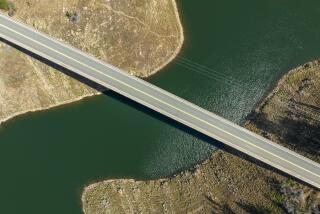Dry Definition Stirs Emotions Over Wetlands
- Share via
SIOUX FALLS, S.D. — When is wet land a wetland?
Answering that question is a science: analyzing the vegetation and soil. But it is an art as well. For wet land is a wetland depending, in part, on how wet it is--and how often and for how long.
And that’s often a controversial call.
Farmers in eastern South Dakota, for instance, long have complained that every sliver of soggy ground is officially deemed a wetland and hailed as an environmental treasure. By law, they’re allowed to farm wetlands. But they can’t drain them--not if they hope to get government subsidies. So wetlands have become a major nuisance: Tractors get stuck in them, noxious weeds take them over and any crop that’s planted in them is sure to drown.
“They’re a pain in the neck,” said Beverly Salmen, who runs a 1,150-acre farm with her husband, Wayne.
But a recent policy change by the state agency that defines wetlands has given farmers hope for a change. It’s also stirred environmentalists’ wrath.
For while farmers view these damp patches as aggravations, some biologists consider them gems. And the biologists predict dire consequences--including a drastic thinning-out of the duck population--if the wetlands are drained.
“We realize these are just little bits [of land], but all those little bits add up to a large number,” said Chris Hesla of the National Wildlife Federation, which has teamed up with other groups to sue the Natural Resource Conservation Service for changing its policy.
The dispute stems, in part, from South Dakota’s topography.
The northern plains are known as “prairie pothole” country because the vast, fertile fields are pocked with little depressions--as many as several dozen an acre. Some look like miniature craters. Others are more linear, blending in well with surrounding fields. Both attract scores of species, including songbirds and ducks migrating north for the summer and the insects that nourish them.
Most prairie potholes fill with water regularly each spring and remain wet for a month or two. But some are more ephemeral, saturated only in years of extreme rain. They’re the ones at issue.
Under the old policy, the conservation agency designated these patches as wetlands even if they were moist just one year in a dozen. Regulators examined year after year of aerial photos. If a particular spot had the right soil and vegetation for a wetland and a photo showed it wet even once, including after a major flood, then boom, it was permanently designated as a wetland, never to be drained.
Now, the conservation agency says that criterion was far too stringent. “To be brutally honest, we were wrong,” conservationist Brian Top said.
Under the revised procedure, regulators are instructed to declare a wetland only if a given patch of soil is wet during years of “normal” precipitation. If it collects moisture only during extraordinary rains, it’s taken off the books, and farmers can drain it as they please.
To farmers, that sounds logical. To environmentalists, it’s a travesty.
“A wetland is a wetland is a wetland,” said Rich Day of the National Wildlife Federation. “Whether there’s water in it or not, it’s still a wetland. That’s the point they’re trying to get away from.”
Conservation agency officials say all they are trying to do is make their policy consistent with that in neighboring states. They insist they can be trusted not to destroy prized habitat.
“I’ve been taking heat [from farmers] for delineating wetlands strictly for so long. I’ve been cursed at and threatened,” said Karen Cameron-Howell, a conservationist at the agency. “Now, [environmentalists] are on me for being soft on wetlands? That’s insulting.”
No one has accurate figures on how many acres of wetland will be affected. The agency says potholes will almost never be drained and insists the only linear stretches that will go are of little use to animals. But a quick look at other states fuels critics’ alarm.
“Are you sitting down?” asked Kurt Forman, a biologist for the U.S. Fish and Wildlife Service. “Then I’ll give you the Iowa figures. Iowa has drained 98% of its prairie potholes.” Minnesota, he said, has drained 75%.
If destruction of that magnitude occurred in South Dakota, mallards in particular could suffer. Most of the 11 million ducks that pass through the Central Flyway, which stretches south to the Gulf of Mexico, rely on prairie potholes for the water, food and cover they need to get through their migrations. So for hunters and conservationists, South Dakota’s new policy is “a very serious concern,” said Lloyd Jones of the Delta Waterfowl Foundation.
In response to the environmentalists’ lawsuit, the conservation agency has suspended its rules until Aug. 20 at the latest, seeking firmer data. Farmers, biologists and hunters have weighed in on the policy at public meetings.
But the only conclusion just about everyone can agree on was voiced by Dave Diedrich, a corn and soybean farmer: “It’s all in the definition of wetlands.”
More to Read
Sign up for Essential California
The most important California stories and recommendations in your inbox every morning.
You may occasionally receive promotional content from the Los Angeles Times.













